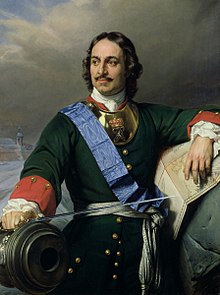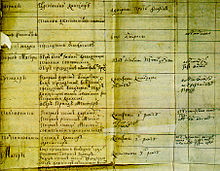User:LittleRoughRhinestone/russianhistoryassignment

Government reform under Peter I refers to modifications made to the state apparatus of Russia during the rule of Peter I.
Peter ascended to the throne in 1682; he ruled jointly with his half-brother Ivan V. After Ivan's death in 1696, Peter implemented a series of sweeping reforms aimed at modernizing Russia, modeled on Enlightenment ideals and influenced by advisers from Western Europe. At first, these reforms were intended to support the Great Northern War; later, more systematic reforms significantly changed the internal construction and administration of the state.
Background[edit]
During the Great Northern War (1700-1721), which dominated most of Peter's reign, Russia, along with a host of allies, seized control of the Baltic Sea from Sweden and gained considerable influence in Central and Eastern Europe. The war, one of history's costliest at the time, consumed significant financial and economic resources, and the administrative system Peter had inherited from his predecessors strained to gather and manage resources. During his Grand Embassy (Великое посольство), Peter conducted negotiations with a number of European powers to strengthen his position against Sweden and the Ottoman Empire, and his exposure to the developed nations of Western Europe motivated him to take steps toward turning Russia into an industrial economy. Despite Russia's vast size and considerable natural resources, a number of factors, including corruption and inefficiency, hampered economic growth. Peter believed that targeted reform could not only strengthen his hold on power, but increase the efficiency of the government, and thus better the lot of his people.
Another major goal of Peter's reform was reducing the influence of the Boyars, Russia's elite nobility, who stressed Slavic supremacy and opposed European influence. While their clout had declined since the reign of Ivan the Terrible, the Boyar Duma, an advisory council to the tsar, still wielded considerable political power. Peter targeted the boyars with numerous taxes and obligatory services,
Like most of Russia's legal system at the time, Peter's reforms were codified and articulated in a series of royal decrees (Russian: указ, literally "imposition"), issued chiefly between 1700 and 1721.
Provincial Reform[edit]
Prior to Peter's rule, Russia's administrative system was relatively antiquated compared to that in many Western European nations. The state was divided into districts, which mostly consisted of large cities and their immediate surrounding areas; this system divided the population unevenly and was extremely clumsy to manage. Beginning in 1708, Peter abolished these old national subdivisions and established in its place eight (later ten) provinces (Областий, oblastiy), each with a royal governor. Another decree in 1713 established a Landrat (Ландрат, from the German word for "national council") in each province, staffed by civil servants.
In 1719, after the establishment of the Collegia, Peter remade Russia's administrative districts once more. The new Russian oblasts were modeled on the Swedish system of provinces, in which larger, more politically important areas received more political autonomy, while smaller, more rural areas were controlled more directly by the state.
Table of Ranks[edit]

Peter's distrust of the elitist and anti-reformist Boyars culminated in 1722 with the creation of the Table of Ranks (Russian: Табель о рангах; Tabel' o rangakh), a formal list of ranks in the Russian military, government, and royal court. The Table of Ranks established a complex system of titles and honorifics, each classed with a number (I to XIV) denoting a specific level of service or loyalty to the Tsar. The origins of the Table of Ranks lie in Russia's military ranking system, which was also significantly modified and revised under Peter's rule.
The establishment of the Table of Ranks was among the most audacious of Peter's reforms, a direct blow to the power of the Boyars which changed Russian society significantly. Previously, high-ranking state positions were hereditary, but with the establishment of the Table of Ranks, anyone, including a commoner, could work their way up the bureaucratic hierarchy with sufficient hard work and skill. A new generation of technocrats soon supplanted the old Boyar class and dominated the civil service in Russia. With minimal modifications, the Table of Ranks remained in effect until the Russian Revolution of 1917.
Finance and Trade[edit]
Fighting the Great Northern War required unprecedented economic resources, and Russia's yawning budget deficit and aging infrastructure meant that the state could not effectively allocate resources and money in wartime. Peter's government was constantly in dire need of money, and at first it responded by monopolizing certain strategic industries, such as salt, alcohol, oak, and tar. Peter also taxed many Russian cultural customs (such as bathing, fishing, beekeeping, and wearing beards) and issued tax stamps for paper goods. [1] However, with each new tax came new loopholes and new ways to avoid them, and so it became clear that tax reform was simply not enough.
The solution was a sweeping new poll tax, which replaced a household tax on cultivated land. Previously, peasants had skirted the tax by combining several households into one estate; now, however, each peasant was assessed individually for a tax of 70 kopeks, paid in cash. This was significantly heavier than the taxes it replaced, and it enabled the Russian state to expand its treasury almost sixfold between 1680 and 1724. [2] Peter also pursued proto-protectionist trade policies, placing heavy tariffs on imports and trade to maintain a favorable environment for Russian-made goods.
Class structure[edit]
Peter's reign deepened the subjugation of serfs to the will of landowners. He firmly enforce class divisions, believing that "just as the landowner was to be tied to service, the townsman to his trade or handicraft, so the peasant was tied to the land." [3] Peter endowed estate-owners to broad new rights, including a requirement that no serf leave his master's estate without written permission. Furthermore, Peter's new tax code significantly expanded the number of taxable workers, shifting an even heavier burden onto the shoulders of the working class.
A handful of Peter's slightly more progressive reforms imitated Enlightenment ideals; he did, for example, create a new class of serfs, known as state peasants, who had broader rights than ordinary serfs, but paid dues to the state. He also created state-sanctioned handicraft shops in large cities, inspired by similar shops he had observed in the Netherlands, to provide products for the army. Evidence even suggests that Peter's advisers recommended the abolition of serfdom and the creation of a form of "limited freedom" (a reality that did not come to pass until two centuries later).[4] Nevertheless, the gap between slaves and serfs shrank considerably under Peter, and by the end of his reign the two were basically indistinguishable.
Success of Peter's Reforms[edit]
Peter's reforms set him apart from the Tsars that preceded him. In Muscovite Russia, the state's functions were limited mostly to military defense, collection of taxes, and enforcement of class divisions. In contrast, legislation under Peter's rule covered every aspect of life in Russia with exhaustive detail. [5]
marked the beginning of Russia's modern history, and they significantly affected the lives of nearly every Russian citizen. The success of reform also contributed greatly to Russia's success in the Great Northern War; the increase in revenue and productivity increased the strength of the Russian war machine.
See also[edit]
References[edit]
Sources[edit]
- Cracraft, James. The Revolution of Peter the Great. Cambridge: Harvard University Press, 2003.
- Raeff, Marc. Peter the Great Changes Russia, 2nd edition. Lexington: D.C. Heath and Company, 1972
- Raeff, Marc. Problems in European Civilization: Peter the Great, Reformer or Revolutionary? Boston: D.C. Heath and Company, 1963.
- Riasonovsky, Nicholas. A History of Russia, 8th edition. New York: Oxford University Press, 2011.
- Sumner, B.H. Peter the Great and the Ottoman Empire. Hamden: Archon Books, 1965
- Sumner, B.H. Peter the Great and the Emergence of Russia. London: English Universities Press, 1960
- Vernadsky, George. Political & Diplomatic History of Russia. Boston: Little, Brown, and Company, 1936.
Category:Politics of the Russian Empire Category:Government of the Russian Empire
